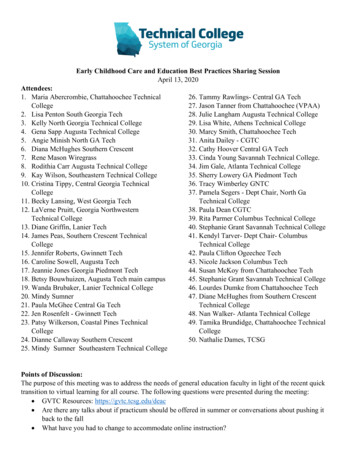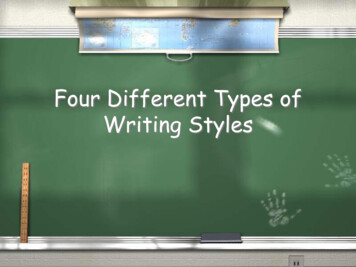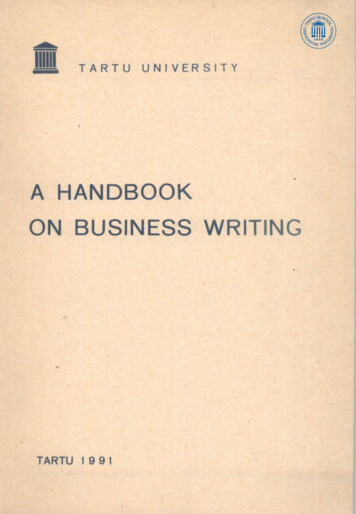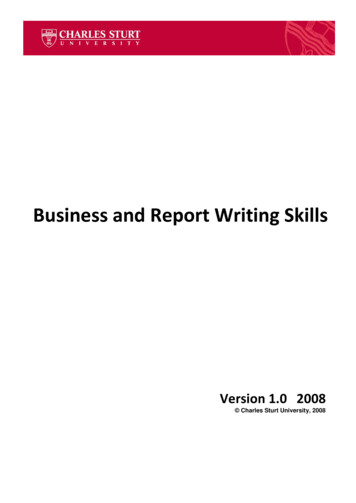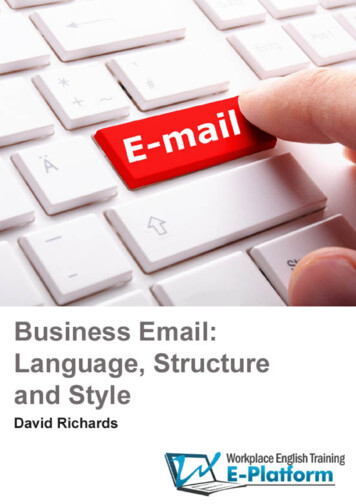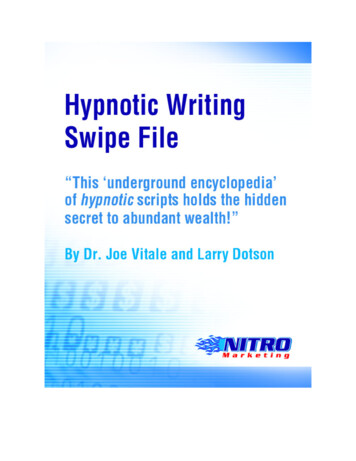
Transcription
Tech Writing HandbookAuthorsKyle Wiens, CEO, iFixitJulia Bluff, Lead Writer, iFixit
Tech WritingHandbookThis handbook will teach youhow to create everything frommanuals to work instructions.We’ll help you avoid the mostcommon pitfalls of tech writing,from poor planning to outdatedpublishing.AuthorsKyle Wiens, CEO, iFixitJulia Bluff, Lead Writer, iFixitChapter 0Welcome!.3Chapter 1Look before you write.5Chapter 2Being concise.7Chapter 3Crystal clarity.10Chapter 4Communicating with style.13Chapter 5Audience.17Chapter 6Photographing the process.19Chapter 7Using other visuals.25Chapter 8Organizing your content.30Chapter 9Legal requirements.34Chapter 10Publishing.36Chapter 11After you write.40Brought to you byAppendix A: Deep diveManufacturing work instructions.42
Tech Writing Handbook3CHAPTER 0Welcome!So, you’ve decided to write a manual. We extend our hand in heartycongratulations of the do-it-yourself moxie that led you here.Welcome to the world of technical communication!Now, at this very moment, you may be chuckling to yourself, “Technical communication Isn’tthat an oxymoron?”We get it. Bad manuals happen a lot. It’s a universal experience: You take Junior’s Christmasgift out of the box, crack open the assembly manual, and, suddenly, everything goes horribly,horribly wrong. Three hours later, all you have to show for your effort is a mutant tricycle.Junior will not be pleased.The best way to learn something is to have an expert teach you. But manuals are the nextbest thing. Great manuals, like the ones from iFixit or Mackie, are teachers.
Tech Writing HandbookAnd we suspect that’s why you’re here. You want to write a manual that actually teaches peoplehow to do things.We want to help. This program will teach you how to write how-to guides, work instructions,and service manuals — from planning, to writing, to publishing. We’ll also help you avoid themost common pitfalls of tech writing.Manuals are important. Whether you’re writing about how to perform maintenance on a CNCmachine, use video editing software, bake a soufflé, or rebuild an engine, you’re teachingsomeone something new. If your manual succeeds, the reader will have done something thatwasn’t possible without your help. And that’s pretty amazing.4
Tech Writing Handbook5CHAPTER 1Look before you writeWriting effective instructions is an achievement. Modern instructionsshouldn’t just be a list of useful directions. They embrace the aestheticand conventions of our time: highly visual, sleek, interactive,and well-designed. And when they’re done right, they’rea pathway to empowerment.Right now, you’re probably excited to get writing. But before you start galloping off into thetech writing sunset, know this: most of the manuals and guides out there are written by people who have no firsthand knowledge of the subject matter. We think that’s a problem. It takesmore than just writing skill to write a good manual: it also takes understanding. There are twolaws of tech writing:1. Know thy product and process2. Talk to thy expertsKnow thy products and processThe first requirement for tech writing is knowledge. You can’t teach someone how to dosomething until you’ve done it yourself. If you’re writing assembly instructions, put the producttogether. If you’re writing about software, use the program. If you’re writing a product manual,you should know the product inside and out. Use it, take it apart, figure out how it works andwhat it’s meant to do.Once you think you know the process, try to teach it to someone else. Teaching is a great wayto solidify your knowledge, and what you learn from watching your student struggle will makeyour manual better.
Tech Writing HandbookTalk to thy expertsIf you’re not an expert at what you’re writing about, talk to someone who is. Chat with thedevelopers, technicians, or designers. Ask them to give you a walkthrough of the product,process, or software. Ask them how it’s made, how it’s done, and why things are the way theyare. Then, keep asking if you need more help.Glean as many stories from them as you can. Understanding the process that goes intomaking something will clarify your understanding.How manuals are usually writtenTech writers create a first draft based on initial functional specifications. Of course, the realproduct barely resembles the spec by the time the manual is written. The first draft is a totalwaste of time. As part of the frustrating review process, engineers give the writers hand scribbled notes. Tech writers assemble another draft, which engineers promptly rip apart. And theprocess starts over again. Finally, the document is published.But it doesn’t have to be that way. The faster and more frequent the interactions betweenengineer and writer, the better the final product will be.6
Tech Writing Handbook7CHAPTER 2Being conciseStyle tip #1: Be direct and get to the point. Then stop writing.That rule applies doubly if you’re writing for the internet. Chrome, Safari, and Firefox are allcalled web browsers instead of web readers for a reason. People don’t read web pages.They scan, hunting and pecking for words and phrases that they find pertinent. The averageperson spends just seconds on a web page, reading only about 20% of the text. The moreconcise you are, the more information readers actually read.Even paper manuals aren’t “well read,” in the classic sense. No one curls up at night with amanual. Just like on web pages, people look for the information that they want. The moretext-dense manuals are, the less likely people will dig through them.Check out this example of an actual warranty statement from an actual kitchen appliance:Example 1: We suggest you complete and return the enclosed product registration cardpromptly to facilitate verification of the date of original purchase. However, return of theproduct registration card does not eliminate the need for the consumer to maintain theoriginal proof of purchase in order to obtain the warranty benefits. In the event that you donot have proof of purchase date, the purchase date for purposes of this warranty will bethe date of manufacture.It’s only three sentences, but it’s dense, impersonal, and wordy. Here’s our revision:Example 2: Please return your completed product registration card so we can verify yourpurchase date. Keep the original proof of purchase to secure your warranty benefits. If youdon’t know the purchase date, give the manufacture date instead.Isn’t that better?
Tech Writing Handbook8How to make paragraphs more concise Lead with the most important information: Front-loaduseful details. Assume that your reader isn’t going to slogthrough an entire paragraph. When you start with theimportant stuff, your readers take the essential point withthem—even if they don’t read everything. Get rid of unimportant information: Readers want justthe facts, so eliminate any off-topic information. Ditchextra bits and tangents. If you’re teaching us how to rebuild a car engine, we don’t need to hear the productionhistory of the Mustang. Just give us directions. Check your word count: Example 1 from above has 76words. Our revised paragraph comes in at 37 words.Saying the same thing in half the words is a great goal.Pro tip: Concision reduces asmany words as possible withoutchanging the meaning.How to make sentences more conciseShort sentences are your friend: Writers eager to appear smart often use really, really,very quite long sentences. Pro tip: Don’t do it. Overly long sentences are confusing. Aim forsentences that have no more than 24 words. Yeah, we know—sometimes your product nameis longer than that. But do your best. Your paragraph will flow better with a healthy mix ofsentence lengths.Here’s a long sentence from a backhoe manual:Assemble small 90 adapter fitting to outlet port of filter base and orient so that free endof fitting will point toward backhoe and angled about 30 upward from horizontal.Now, here’s our revision with three short sentences instead of one long one:Attach the small 90 adapter fitting to the port of the filter base. The free end of the fittingshould point toward the backhoe. Angle the fitting about 30 upward of horizontal.Dump any empty words: Empty words just sit there, like a lump on a long-winded log. Take alook back at the warranty example. The warranty used the phrase “In the event that.” But “inthe event that” is just a fancy way of saying “if.” Why use four words when one will do?Reduce the amount of “to be” verbs: “To be” verbs laze about without actually doing much.Of course, don’t go overboard and weed every single one out of your verb population. Somesentences require “to be” verbs—no way around it. But, where you have a choice, replacelazy verbs with active verbs—ones that move the sentence forward. Fun fact: This paragraphcontains no “to be” verbs.
Tech Writing Handbook9Here’s an example from a car assembly manual: “If you damageany parts, it will probably be because they were either not storedproperly or, the wrong tool was used to install them.”That’s three passive verbs in the same sentence. We eliminatedthe lazy verbs for our revision: “Storing a tool improperly or usingthe wrong installation tools can lead to damaged parts.“Use passive voice strategically: Using passive voice doesn’t makeyou a bad person, no matter what your English teacher said in 10thgrade. Just use passives purposefully. Unless you have a reasonfor using passive voice, switch to active voice.Here’s an example of passive voice from a user manual: “A booster seat should be used toobtain proper seat belt fit.”Who is obtaining the proper fit? Who is doing the using? That’s the thing about passive voice:No one knows. Sentence construction isn’t an episode of Murder She Wrote. No one shouldhave to guess who did what. If you’re writing directions, start with a verb.Let’s try rewriting that using active voice: “Use a booster seat to properly fit the child’s seatbelt.”
Tech Writing Handbook10CHAPTER 3Crystal clarityImagine your words are a sliding glass door. Now imagine smashing intothe glass door—hard. That’s how clear your writing should be:dangerously clear.Avoiding confusion: A commonsense approachCheck out this product description:Work has been proceeding in order to bring perfection to the crudely conceived idea ofa machine that would not only supply inverse reactive current for use in unilateral phasedetractors, but would also be capable of automatically synchronizing cardinal grammeters.Such a machine is the Turbo-Encabulator.Did you get that? Yeah, we didn’t either.The Turbo-Encabulator is completely made up. But, when a description of the Turbo-Encabulator ran as a joke in a 1946 edition of Time, most people thought it was real. Why? Becausethey’d seen so many other bad manuals and product descriptions like it before. The Turbo-Encabulator is a parody of technical writing and, as with all parodies, it’s funny because it’sbased on reality.This, on the other hand, is 100% bonafide:The delay knob moves the main sweep horizontally, and it pauses at 0.00s, mimicking amechanical detent. At the top of the graticule is a solid triangle symbol and an open triangle symbol. The symbol indicates the trigger point and it moves with the Delay time knob.The symbol indicates the time reference point and is also where the zoom-in/zoom-out isreferenced.
Tech Writing Handbook11Granted, this oscilloscope operator’s manual isn’t designed for a novice. But the writers unnecessarily mention a “mechanical detent” and a needless passive sentence “is referenced.”It just makes the sentence hard to understand.So, how do you avoid confusing your reader? Keep in mind that real people will read yourwriting, and they probably aren’t as technically knowledgeable as you are. Here are a coupleof suggestions to make your writing more humane:Use plain language: Did you know that Plain Languageis a movement? Plain language “is focused on readers.” Itensures that your readers can “quickly and easily find whatthey need, understand what they need, and act appropriately on that understanding.” Use plain English, words thatmost people understand, and short sentences.Lay off the jargon: Or, something surprising while readingat least, use it as sparingly as possible. Jargon is only usedwithin a specific discipline. Chances are, no one outside ofyour industry knows what it means. If you absolutely needjargon, do your best to provide context, short definitions, oreven a glossary of terms. Sometimes, jargon just makes yousound silly. Case in point:Simplicity can be striking. Welearned something surprisingreading On Writing Well by William Zinsser: “Of the 701 wordsin Lincoln’s Second InauguralAddress, a marvel of economyin itself, 505 are words of onesyllable and 122 are words of twosyllables.”Extra-Lift Carriage Control LeverBrings small items close to the top of the toaster,for easy removal.An Extra-Lift Carriage Control Lever? For easy toast removal, you say? Good for you but the rest of us just call that a“lever.”Don’t turn verbs into nouns: Verbs are happy being verbs.Don’t force them to become nouns when they don’t wantto be nouns. Verby nouns makes your sentences unhappy,which in turn makes your readers unhappy.Here are some completely unparsable work instructions foran automotive assembly line:With the control levers (handles) fully depressed:for the clutch—complete disengagement of the engine from the transmission; smoothshifting of gears means correct adjustment of the clutch cable.
Tech Writing Handbook12Now, we’re not sure what’s happening with the punctuation—and we’ll likely never sort it out.But the nounification of those verbs, we can rectify. Here’s how we did it:Completely disengage the engine from the transmission. Correctly adjust the clutch cablefor smooth shifting gears.Articles are not the enemy: Articles are those littlewords in front of nouns, like “the,” “an,” and “a.”When writing instructions, people have a tendency to skip articles altogether. They say things like,“Disconnect cord from wall” instead of “Disconnectthe cord from the wall.” We have yet to suss outthe reason for this omission, but we assume that itis rooted in a deep-seated desire to sound like arobot. Until the singularity strikes, feel free to usearticles whenever they are called for.Turn it over to a novice: Sometimes it can be hardto tell when your writing is unclear. Want to makesure? Give your writing to someone who knowsnothing about the subject matter. Try a HallwayUsability Test: hand what you’re working on to fiverandom people who just happen to walk down the hall. Every time someone says, “I don’tknow what this means,” you’ve gone off the rails on the clarity train.iFixit’s original field service manuals were tested on unsuspecting art students: we handedthem a computer and our new manual and watched them use the instructions to take it apart.Every time they got confused, we knew we had a problem. We used what we learned fromtheir attempts to make the service manual better.Don’t use weasel words: Some words weasel into your sentence and steal your oomph.Words like “quite,” “mostly,” “slightly,” “seems,” “sort of,” “pretty,” and “somewhat” are built-insentence loopholes. They signal to the reader that you mean what you say just not really. Isthe screw “pretty hard to tighten” or is it just hard to tighten? Is running into your ex “fairlyuncomfortable” or is it just downright uncomfortable? Say what you mean without wishywashy words.
Tech Writing Handbook13CHAPTER 4Communicating with styleManuals aren’t pulp fiction page turners. But that doesn’t mean they haveto be a snooze-fest. Instructions are important. People need them.As writers, it’s our job to make reading manuals not feel like a chore.Write with style.Style doesn’t necessarily equate to poetic language and intense imagery. Every writer,no matter how technical the material, has a style. Style is how you, as an author, choose tocommunicate with your audience. It includes things like tone, humor, and the degree offormality in your writing. Good style is about making decisions—about knowing what toinclude and what to omit, when to follow the rules and when to break them.You can break all the rules that we’ve listed, but you shoulddo so for a clear reason. For example, in Chapter 2 we toldyou to be direct and avoid tangents, but sometimes thebest way to explain a feature is to include an anecdote. Inthat specific moment, it’s fine to break that rule. The benefitof storytelling outweighs the perks of being concise. Justdon’t go around breaking rules without good reasons fordoing so.Mackie’s user guides are an inspiration. Mackie’s style isinstantly recognizable. They know their audience—professional sound engineers—and how to reach them. Theyaddress their readers like friends, while still passing ondetailed instructions and expert-level knowledge.It’s okay to write informally—butthat degree of informality shouldvary depending on subject matter. If you’re writing maintenanceprocedures for a nuclear powerplant, it’s probably best to stickto a formal, business-like tone. Ifyou’re writing instructions on howto build a backyard barbecue,feel free to write in a style that isfriendly and informal.
Tech Writing Handbook14Here are some style highlights of Mackie’s style:Humorous instructions:Pack yourself a big lunch and go fora nice walk outside. Have a picnicand lie back and dream. Things aregoing to be so good now.Realism:This icon will lead you to someexplanations of features andpractical tips. Go ahead andskip these if you need to leavethe room in a hurry.Anecdotes:The dual-purpose mute/alt 3-4 switch is a Mackie signature. When Gregwas designing our first product, he had to include a mute switch foreach channel. Mute switches do just what they sound like they do. Theyturn off the signal by “routing” it into oblivion. “Gee, what a waste,” hereasoned. “Why not have the mute button route the signal somewhereuseful, like a separate stereo bus?”So mute/alt 3-4 really serves two functions—muting (often used duringmixdown or live shows), and signal routing (for multitrack and live work)where it acts as an extra stereo bus.Want to develop your own distinctive style?Here are a few considerations:Humor: Everyone likes humor. Apply with extreme care, however. Humor and wit is almostimpossible to capture in translation, so only use it if you’re writing for a local audience. Afterall, what’s funny in the U.S. might not be funny in Iceland, or Turkmenistan, or Japan. Plus,humor is hard to get right. It takes writing, rewriting, whittling, and gumption. And sometimes,it’s not appropriate—don’t use it in precautions, and not in anything that may have legal ramifications. Also, sarcasm may sound funny in your head, but it usually just comes off as mean.
Tech Writing Handbook15Despite the drawbacks, humor is sometimes the most memorable way to make a point.You can talk about capacitors until you’re blue in the face, but make people laugh and they’llremember it.Some tips on writing funny: Only write it down if it makes you laugh. Erase the funny part and write it better. Stop trying to be funny. Funny works best when it’s spontaneous. Don’t be mean to real people. The only actual person you’re allowed to make funof is yourself. Read something hilarious before you write. We recommend Dave Barry, funnyman journalistextraordinaire. Humorist Sherman Alexie suggests, “Write naked—that will make you laugh.” Don’t ever trythis in the office. It’s still hilarious, but you’ll probably get fired.Set the tone: Your writing can be serious, authoritative, journalistic, friendly, humorous, oranything else you’d like. As a writer, you dictate the tone. But don’t change halfway throughyour document. Find one you like and stick with it.Addressing the audience: The classic writing conundrum: Can a writer say “you” whenreferring to the audience? Sometimes people avoid the second-person pronoun to achievea sense of distance and impartiality—especially on scientific topics. But if you are tellingreaders what to do, “you” and “your” is perfectly acceptable. In fact, when used purposefully,the informal “you” sounds more natural and encouraging.Ex: “How to upload images onto your computer” vs. “Uploading images to a computer.”Ex: “Be careful when you pull the wire from its connector” vs. “The wire should be pulledfrom the connector carefully.”Ultimately, the choice is up to you.Using contractions: To use contractions or not to usecontractions? That’s the question. We have the answer:‘Tis nobler to use them. Contractions shorten your sentences and improve the overall flow. If you doubt us onthis point, try reading a paragraph without contractionsaloud. It sounds unnatural. Swap in contractions and theparagraph sounds human again.Something to consider: If you planto translate your manual into anotherlanguage, using a lot of contractionscan make the job more difficult.
Tech Writing HandbookShort paragraphs are key: The rule of a well-formed, five-sentence paragraph is suspendedin tech writing. You don’t need theses or topic sentences for manuals, and you don’t needlong paragraphs to defend your assertions.You can start a new paragraph whenever you start a new thought. (See what we did there?)Readers like short paragraphs. Short is easier to skim. We’re fans of using short, declarativebullets to break up content into little readable chunks.Internationalization: If you plan on publishing for an international audience, your manual willneed to be translated, which is an expensive process. The right style will make the translationprocess much easier. Some general style tips are the same: It’s even more important to limityour vocabulary to simple/common words. But when writing for translation, avoid jokes andidioms (they don’t translate well), use contractions in moderation, and be consistent with yourphrasing. This tutorial, for example, would be very hard to translate into another language.We’ve used a lot of colloquialisms and idioms, quite a bit of of creative language, and wedidn’t bother to limit our vocabulary. That’s a decision we made to keep this (long) tutorialboth informational and engaging. These are the kinds of tradeoffs you’ll have to make as awriter.There’s enough nuance to internationalization to fill a book, so check out The Content Wrangler*for more tips.* or-writing-international-technical-content/16
Tech Writing Handbook17CHAPTER 5AudienceWriting never takes place in a vacuum (unless you’re literally in a vacuum,which would be incredibly uncomfortable). When you’re writing a manual,you’re always writing to someone. Figure out who that is. The more youknow about them, the better your writing will be.Optimize your manual to match the target audience’s expertise. The Books for Dummiesseries, for example, has successfully targeted one narrow audience: the clueless newbie. ForDummies publishers have a book on everything from writing résumés to coaching children.Each one features diagrams, illustrations, extended explanations, context, and basic tips.Auto Repair for Dummies has a whole chapter dedicated to changing your car’s oil. It coverswhat oil does in the car, the pros and cons of synthetic oil, and instructions—15 pages of ‘em.If the book was entitled Auto Repair for Experts, however, that whole chapter could be boileddown to a single sentence: “Change the oil.” Unless they’re changing the oil on a supercar, nocar expert will need 15 pages of instruction for an oil change.Knowing your audience means knowing what to include and what not to include. It means youknow how many steps it’ll take to explain something to them. It means you know how longyour manual is going to be and what sort of language you can get away with using.Here are a few things to keep in mind:Reading level writing levelYou shouldn’t write over your audience’s head. You also shouldn’t write drastically under it,although in our experience this is rare.
Tech Writing HandbookThe average American adultreads at about a ninth-gradelevel.18Flesch-Kincaid Readability Tests are the most common wayto ascertain a text’s readability. Flesch-Kincaid scores ease ofreading on a scale of 0-100, with 100 being the easiest to read.Another Flesch-Kincaid test estimates reading level (K-12).To show you just how wide manuals can miss the mark, we decided to test a manufacturer manual for a popular product—Apple’sMacBook Pro—on the Flesch-Kincaid scale. The Apple user manual scored an abysmal –2.2and required a reading grade level of 24. (In case you were wondering: no, grades don’t gothat high.) To put this in context, Shakespeare’s Macbeth is at an 11th grade reading level.Here’s a safe rule of thumb: A user manual shouldn’t be more difficult to read than Shakespeare.iFixit’s repair manual for the same device scored at a fourth grade reading level. The lower thereading level, the more likely your readers will be able to understand what you’re saying.Not sure how to gauge the reading level of your writing? You can use sites like The ReadabilityTest Tool to measure readability on existing web sites. Word and Excel already have readabilitytools built into them—they just need enabling.Existing knowledgeWhat can you assume your audience already knows? Technical writers often forget whattheir audience knows and, especially, what they don’t. Mechanical engineers sometimeswrite manuals that sound like they are written for other mechanical engineers—but if thetarget audience isn’t super tech savvy, then rambling on about shear load, helical gearing,and kinematic chains without an explanation is a problem.Military organizations are amazingly bad at this. They have so many acronyms that youhave to spend months learning them all before you can communicate with anyone. Here’san example from an Army Shipboard Operations manual:a. Emergency Training. Emergency requirements or training necessary for imminent deployment usually will come from DA through a MACOM such as FORSCOM. Army aviationunits will receive the higher command's assistance in scheduling ships and other resources.The standard practice in technical writing is to spell out an acronym on its first usage, puttingthe acronym in parentheses. This ensures clarity for all readers.
Tech Writing Handbook19CHAPTER 6Photographing the processThey say a picture is worth a thousand words. They’re right. Don’t just tellreaders how to do something—show them.Historically, photos haven’t gotten much love in manuals—even in service manuals wherephotos might be the difference between poorly installed brakes and a car that stops whentold. The holy grail of standardization, ISO 9001 documentation, is usually text only. Giventhe historical expense of printing costs, this made sense. But that was then, and this is now.Welcome to the digital revolution: the world is your high-resolution oyster.iFixit teaches people how torepair their electronics. That’sdicey business. After all, thereare tons of little componentsand little connectors in anygiven device. Take Zero-Insertion Force (ZIF) connectors, forexample. Not only are they tiny,but they’re equipped with eventinier, delicate flaps that haveto be pried up and flipped over.Do it the wrong way—a common mistake made by newbietechnicians—and you couldbreak the entire device. Thoseare some pretty high stakes.
Tech Writing HandbookHere are iFixit’s text instructions for freeing the ZIF battery connector in an iPod Nano:Hold down the light-colored socket with your finger. Then use the tip of a spudger to flipthe ZIF cable lock 90º upwards.And while those are good instructions, they aren’t enough. There’s too much room for error.So, iFixit includes high-resolution, color photos with every single step. That way, you canzoom in and figure out exactly what the component looks like, where the flap is, and howto pry it up. Photos like this one have saved the life of many a ZIF connector:Photography brings instructions to life. It makes things more clear. Compare an Ikea manualto iFixit’s self-repair guides. Depending on the level of clarity, repairing your iPhone can bemore accessible than assembling a set of cupboards. That’s the power of photography.20
Tech Writing Handbook21Tips for photographyNot a photography expert? Not to worry! Modern cameras make it surprisingly easy—andfast—to take useful photos. Our tips and tutorials will have you shooting like a pro in a flash.Setting up the photoshootThe most important component for taking pictures is choosingthe right camera. We highly recommended that you use a digital single lens reflex (DSLR) camera to take professional-qualityguide images. If you don’t have a DSLR camera, any point-andshoot camera with at least 6 megapixels will capture images withsufficient resolution.Our company, Dozuki, helpscompanies create step-bystep procedures for servicemanuals, industrial workinstructions, and more.No matter what camera you decide to use, everyhand-held camera is prone to shakes and vibrationsthat cause blurry photos. Using a tripod, even acheap one, keeps your images sharp.The better your lighting is, the less you have topost-process the photo. Unfortunately, your oldbedside lamp just won’t cut it. Despair not! You canconstruct a relatively inexpensive
Tech Writing Handbook 7 CHAPTER 2 Being concise Style tip #1: Be direct and get to the point. Then stop writing. That rule applies doubly if you’re writing for the internet. Chrome, Safari, and Firefox a

